Qingyuan Wu
Directly Forecasting Belief for Reinforcement Learning with Delays
May 01, 2025Abstract:Reinforcement learning (RL) with delays is challenging as sensory perceptions lag behind the actual events: the RL agent needs to estimate the real state of its environment based on past observations. State-of-the-art (SOTA) methods typically employ recursive, step-by-step forecasting of states. This can cause the accumulation of compounding errors. To tackle this problem, our novel belief estimation method, named Directly Forecasting Belief Transformer (DFBT), directly forecasts states from observations without incrementally estimating intermediate states step-by-step. We theoretically demonstrate that DFBT greatly reduces compounding errors of existing recursively forecasting methods, yielding stronger performance guarantees. In experiments with D4RL offline datasets, DFBT reduces compounding errors with remarkable prediction accuracy. DFBT's capability to forecast state sequences also facilitates multi-step bootstrapping, thus greatly improving learning efficiency. On the MuJoCo benchmark, our DFBT-based method substantially outperforms SOTA baselines.
VSC-RL: Advancing Autonomous Vision-Language Agents with Variational Subgoal-Conditioned Reinforcement Learning
Feb 11, 2025Abstract:State-of-the-art (SOTA) reinforcement learning (RL) methods enable the vision-language agents to learn from interactions with the environment without human supervision. However, they struggle with learning inefficiencies in tackling real-world complex sequential decision-making tasks, especially with sparse reward signals and long-horizon dependencies. To effectively address the issue, we introduce Variational Subgoal-Conditioned RL (VSC-RL), which reformulates the vision-language sequential decision-making task as a variational goal-conditioned RL problem, allowing us to leverage advanced optimization methods to enhance learning efficiency. Specifically, VSC-RL optimizes the SubGoal Evidence Lower BOund (SGC-ELBO), which consists of (a) maximizing the subgoal-conditioned return via RL and (b) minimizing the subgoal-conditioned difference with the reference policy. We theoretically demonstrate that SGC-ELBO is equivalent to the original optimization objective, ensuring improved learning efficiency without sacrificing performance guarantees. Additionally, for real-world complex decision-making tasks, VSC-RL leverages the vision-language model to autonomously decompose the goal into feasible subgoals, enabling efficient learning. Across various benchmarks, including challenging real-world mobile device control tasks, VSC-RL significantly outperforms the SOTA vision-language agents, achieving superior performance and remarkable improvement in learning efficiency.
Inverse Delayed Reinforcement Learning
Dec 04, 2024



Abstract:Inverse Reinforcement Learning (IRL) has demonstrated effectiveness in a variety of imitation tasks. In this paper, we introduce an IRL framework designed to extract rewarding features from expert trajectories affected by delayed disturbances. Instead of relying on direct observations, our approach employs an efficient off-policy adversarial training framework to derive expert features and recover optimal policies from augmented delayed observations. Empirical evaluations in the MuJoCo environment under diverse delay settings validate the effectiveness of our method. Furthermore, we provide a theoretical analysis showing that recovering expert policies from augmented delayed observations outperforms using direct delayed observations.
Model-Based Reward Shaping for Adversarial Inverse Reinforcement Learning in Stochastic Environments
Oct 04, 2024



Abstract:In this paper, we aim to tackle the limitation of the Adversarial Inverse Reinforcement Learning (AIRL) method in stochastic environments where theoretical results cannot hold and performance is degraded. To address this issue, we propose a novel method which infuses the dynamics information into the reward shaping with the theoretical guarantee for the induced optimal policy in the stochastic environments. Incorporating our novel model-enhanced rewards, we present a novel Model-Enhanced AIRL framework, which integrates transition model estimation directly into reward shaping. Furthermore, we provide a comprehensive theoretical analysis of the reward error bound and performance difference bound for our method. The experimental results in MuJoCo benchmarks show that our method can achieve superior performance in stochastic environments and competitive performance in deterministic environments, with significant improvement in sample efficiency, compared to existing baselines.
Scaling Value Iteration Networks to 5000 Layers for Extreme Long-Term Planning
Jun 12, 2024

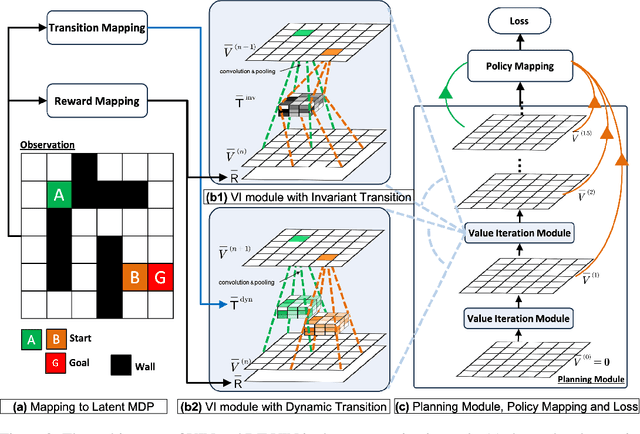
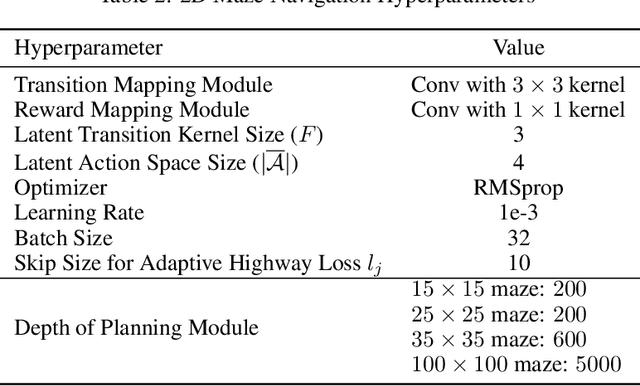
Abstract:The Value Iteration Network (VIN) is an end-to-end differentiable architecture that performs value iteration on a latent MDP for planning in reinforcement learning (RL). However, VINs struggle to scale to long-term and large-scale planning tasks, such as navigating a $100\times 100$ maze -- a task which typically requires thousands of planning steps to solve. We observe that this deficiency is due to two issues: the representation capacity of the latent MDP and the planning module's depth. We address these by augmenting the latent MDP with a dynamic transition kernel, dramatically improving its representational capacity, and, to mitigate the vanishing gradient problem, introducing an "adaptive highway loss" that constructs skip connections to improve gradient flow. We evaluate our method on both 2D maze navigation environments and the ViZDoom 3D navigation benchmark. We find that our new method, named Dynamic Transition VIN (DT-VIN), easily scales to 5000 layers and casually solves challenging versions of the above tasks. Altogether, we believe that DT-VIN represents a concrete step forward in performing long-term large-scale planning in RL environments.
Highway Value Iteration Networks
Jun 05, 2024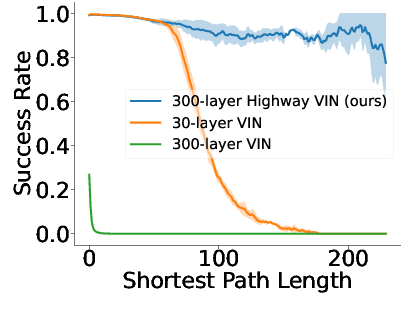



Abstract:Value iteration networks (VINs) enable end-to-end learning for planning tasks by employing a differentiable "planning module" that approximates the value iteration algorithm. However, long-term planning remains a challenge because training very deep VINs is difficult. To address this problem, we embed highway value iteration -- a recent algorithm designed to facilitate long-term credit assignment -- into the structure of VINs. This improvement augments the "planning module" of the VIN with three additional components: 1) an "aggregate gate," which constructs skip connections to improve information flow across many layers; 2) an "exploration module," crafted to increase the diversity of information and gradient flow in spatial dimensions; 3) a "filter gate" designed to ensure safe exploration. The resulting novel highway VIN can be trained effectively with hundreds of layers using standard backpropagation. In long-term planning tasks requiring hundreds of planning steps, deep highway VINs outperform both traditional VINs and several advanced, very deep NNs.
Highway Reinforcement Learning
May 28, 2024



Abstract:Learning from multi-step off-policy data collected by a set of policies is a core problem of reinforcement learning (RL). Approaches based on importance sampling (IS) often suffer from large variances due to products of IS ratios. Typical IS-free methods, such as $n$-step Q-learning, look ahead for $n$ time steps along the trajectory of actions (where $n$ is called the lookahead depth) and utilize off-policy data directly without any additional adjustment. They work well for proper choices of $n$. We show, however, that such IS-free methods underestimate the optimal value function (VF), especially for large $n$, restricting their capacity to efficiently utilize information from distant future time steps. To overcome this problem, we introduce a novel, IS-free, multi-step off-policy method that avoids the underestimation issue and converges to the optimal VF. At its core lies a simple but non-trivial \emph{highway gate}, which controls the information flow from the distant future by comparing it to a threshold. The highway gate guarantees convergence to the optimal VF for arbitrary $n$ and arbitrary behavioral policies. It gives rise to a novel family of off-policy RL algorithms that safely learn even when $n$ is very large, facilitating rapid credit assignment from the far future to the past. On tasks with greatly delayed rewards, including video games where the reward is given only at the end of the game, our new methods outperform many existing multi-step off-policy algorithms.
Variational Delayed Policy Optimization
May 23, 2024Abstract:In environments with delayed observation, state augmentation by including actions within the delay window is adopted to retrieve Markovian property to enable reinforcement learning (RL). However, state-of-the-art (SOTA) RL techniques with Temporal-Difference (TD) learning frameworks often suffer from learning inefficiency, due to the significant expansion of the augmented state space with the delay. To improve learning efficiency without sacrificing performance, this work introduces a novel framework called Variational Delayed Policy Optimization (VDPO), which reformulates delayed RL as a variational inference problem. This problem is further modelled as a two-step iterative optimization problem, where the first step is TD learning in the delay-free environment with a small state space, and the second step is behaviour cloning which can be addressed much more efficiently than TD learning. We not only provide a theoretical analysis of VDPO in terms of sample complexity and performance, but also empirically demonstrate that VDPO can achieve consistent performance with SOTA methods, with a significant enhancement of sample efficiency (approximately 50\% less amount of samples) in the MuJoCo benchmark.
Boosting Long-Delayed Reinforcement Learning with Auxiliary Short-Delayed Task
Feb 05, 2024Abstract:Reinforcement learning is challenging in delayed scenarios, a common real-world situation where observations and interactions occur with delays. State-of-the-art (SOTA) state-augmentation techniques either suffer from the state-space explosion along with the delayed steps, or performance degeneration in stochastic environments. To address these challenges, our novel Auxiliary-Delayed Reinforcement Learning (AD-RL) leverages an auxiliary short-delayed task to accelerate the learning on a long-delayed task without compromising the performance in stochastic environments. Specifically, AD-RL learns the value function in the short-delayed task and then employs it with the bootstrapping and policy improvement techniques in the long-delayed task. We theoretically show that this can greatly reduce the sample complexity compared to directly learning on the original long-delayed task. On deterministic and stochastic benchmarks, our method remarkably outperforms the SOTAs in both sample efficiency and policy performance.
State-wise Safe Reinforcement Learning With Pixel Observations
Nov 03, 2023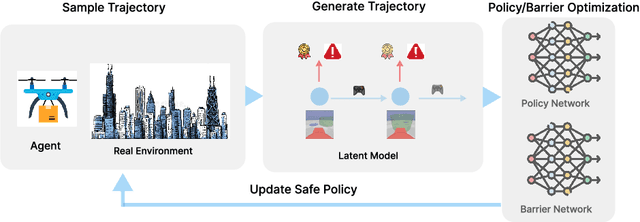


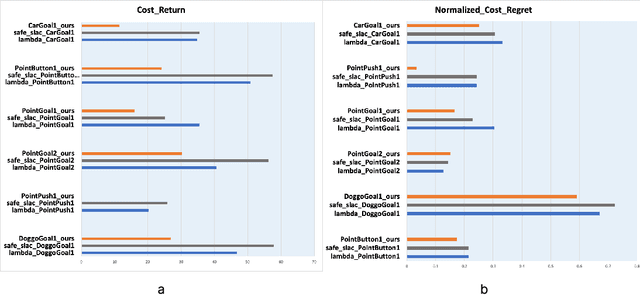
Abstract:Reinforcement Learning(RL) in the context of safe exploration has long grappled with the challenges of the delicate balance between maximizing rewards and minimizing safety violations, the complexities arising from contact-rich or non-smooth environments, and high-dimensional pixel observations. Furthermore, incorporating state-wise safety constraints in the exploration and learning process, where the agent is prohibited from accessing unsafe regions without prior knowledge, adds an additional layer of complexity. In this paper, we propose a novel pixel-observation safe RL algorithm that efficiently encodes state-wise safety constraints with unknown hazard regions through the introduction of a latent barrier function learning mechanism. As a joint learning framework, our approach first involves constructing a latent dynamics model with low-dimensional latent spaces derived from pixel observations. Subsequently, we build and learn a latent barrier function on top of the latent dynamics and conduct policy optimization simultaneously, thereby improving both safety and the total expected return. Experimental evaluations on the safety-gym benchmark suite demonstrate that our proposed method significantly reduces safety violations throughout the training process and demonstrates faster safety convergence compared to existing methods while achieving competitive results in reward return.
 Add to Chrome
Add to Chrome Add to Firefox
Add to Firefox Add to Edge
Add to Edge